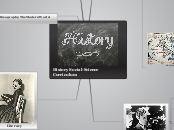
History Social-Science Curriculum
Content

History
10.2.5. Discuss how nationalism spread across Europe with Napoleon but was repressed for a generation under the Congress of Vienna and Concert of Europe until the Revolutions of 1848.
10.5.1. Analyze the arguments for entering into war presented by leaders from all sides of the Great War and the role of political and economic rivalries, ethnic and ideological conflicts, domestic discontent and disorder, and propaganda and nationalism in mobilizing the civilian population in support of “total war.”
10.8.4. Describe the political, diplomatic, and military leaders during the war (e.g., Winston Churchill, Franklin Delano Roosevelt, Emperor Hirohito, Adolf Hitler, Benito Mussolini, Joseph Stalin, Douglas MacArthur, Dwight Eisenhower).

Economics

10.3.6. Analyze the emergence of capitalism as a dominant economic pattern and the responses to it, including Utopianism, Social Democracy, Socialism, and Communism.
10.4.1. Describe the rise of industrial economies and their link to imperialism and colonialism (e.g., the role played by national security and strategic advantage; moral issues raised by the search for national hegemony, Social Darwinism, and the missionary impulse; material issues such as land, resources, and technology).
10.9.3. Understand the importance of the Truman Doctrine and the Marshall Plan, which established the pattern for America’s postwar policy of supplying economic and military aid to prevent the spread of Communism and the resulting economic and political competition in arenas such as Southeast Asia (i.e., the Korean War, Vietnam War), Cuba, and Africa.

Geography

10.2.3. Understand the unique character of the American Revolution, its spread to other parts of the world, and its continuing significance to other nations.
10.3.3. Describe the growth of population, rural to urban migration, and growth of cities associated with the Industrial Revolution.
10.4.2. Discuss the locations of the colonial rule of such nations as England, France, Germany, Italy, Japan, the Netherlands, Russia, Spain, Portugal, and the United States.

Inquiry
10.4.3. Explain imperialism from the perspective of the colonizers and the colonized and the varied immediate and long-term responses by the people under colonial rule.
H-SS AS: Students interpret past events and issues within the context in which an event unfolded
rather than solely in terms of present-day norms and values.
10.5.4. Understand the nature of the war and its human costs (military and civilian) on all sides of the conflict, including how colonial peoples contributed to the war effort.
H-SS AS: Students recognize the complexity of historical causes and effects, including the limitations on determining cause and effect.
10.6.2. Describe the effects of the war and resulting peace treaties on population movement, the international economy, and shifts in the geographic and political borders of Europe and the Middle East.
H-SS AS: Students analyze how change happens at different rates at different times; understand that some aspects can change while others remain the same; and understand that change is complicated and affects not only technology and politics but also values and beliefs.
10.8.5. Analyze the Nazi policy of pursuing racial purity, especially against the European Jews; its transformation into the Final Solution; and the Holocaust that resulted in the murder of six million Jewish civilians.
H-SS AS: Students compare the present with the past, evaluating the consequences of past events and decisions and determining the lessons that were learned.
10.9.7. Analyze the reasons for the collapse of the Soviet Union, including the weakness of the command economy, burdens of military commitments, and growing resistance to Soviet rule by dissidents in satellite states and the non Russian Soviet republics.
H-SS AS: Students understand the meaning, implication, and impact of historical events and recognize that events could have taken other directions.

Citizenship

10.1.1. Analyze the similarities and differences in Judeo-Christian and Greco-Roman views of law, reason and faith, and duties of the individual.
10.1.2. Trace the development of the Western political ideas of the rule of law and illegitimacy of tyranny, using selections from Plato’s Republic and Aristotle’s Politics.
10.2.1. Compare the major ideas of philosophers and their effects on the democratic revolutions in England, the United States, France, and Latin America (e.g., John Locke, Charles-Louis Montesquieu, Jean-Jacques Rousseau, Simón Bolívar, Thomas Jefferson, James Madison).
10.2.2. List the principles of the Magna Carta, the English Bill of Rights (1689), the American Declaration of Independence (1776), the French Declaration of the Rights of Man and
the Citizen (1789), and the U.S. Bill of Rights (1791).
10.9.8. Discuss the establishment and work of the United Nations and the purposes and functions of the Warsaw Pact, SEATO, NATO, and the Organization of American States.
World History, Culture, and Geography: The Modern World Grade 10

Literacy

CCSS.ELA-Literacy.RH.9-10.3. Analyze in detail a series of events described in a text; determine whether earlier events caused later ones or simply preceded them.
CCSS.ELA-Literacy.RH.9-10.6 Compare the point of view of two or more authors for how they treat the same or similar topics, including which details they include and emphasize in their respective accounts.
CCSS.ELA-Literacy.WHST.9-10.9. Draw evidence from literary or informational texts to support analysis, reflection, and research.

CCSS.ELA-Literacy.RH.9-10.1. Cite specific textual evidence to support analysis of primary and secondary sources, attending to such features as the date and origin of the information.
CCSS.ELA-Literacy.WHST.9-10.7. Conduct short as well as more sustained research projects to answer a question (including a self-generated question) or solve a problem; narrow or broaden the inquiry when appropriate; synthesize multiple sources on the subject, demonstrating understanding of the subject under investigation.
CCSS.ELA-Literacy.WHST.9-10.2. Write informative/ explanatory texts to examine and convey complex ideas, concepts, and information clearly and accurately through the effective selection, organization, and analysis of content.

CCSS.ELA-Literacy.RH.9-10.4. Determine the meaning of words and phrases as they are used in text, including vocabulary describing political, social, or economic aspects of history/social science.
CCSS.ELA-Literacy.RH.9-10.8 Assess the extent to which the reasoning and evidence in a text support the author’s claims.
CCSS.ELA-Literacy.WHST.9-10.4. Produce clear and coherent writing in which the development, organization, and style are appropriate to task, purpose, and audience.
